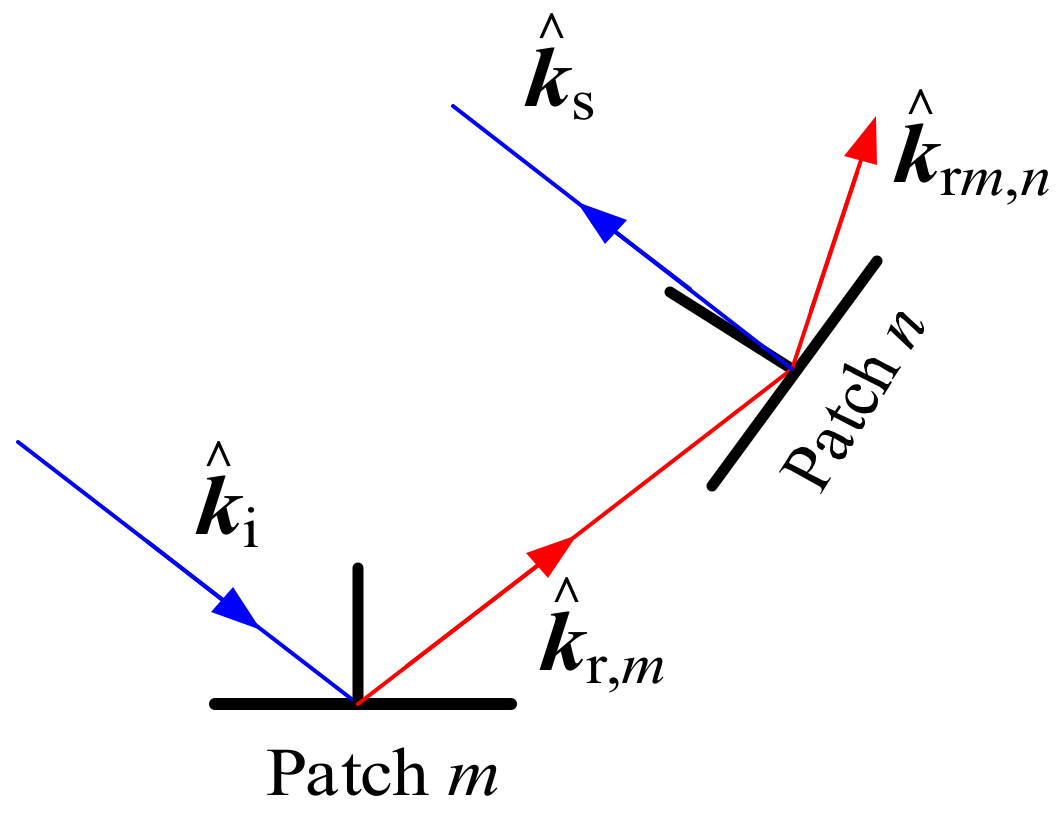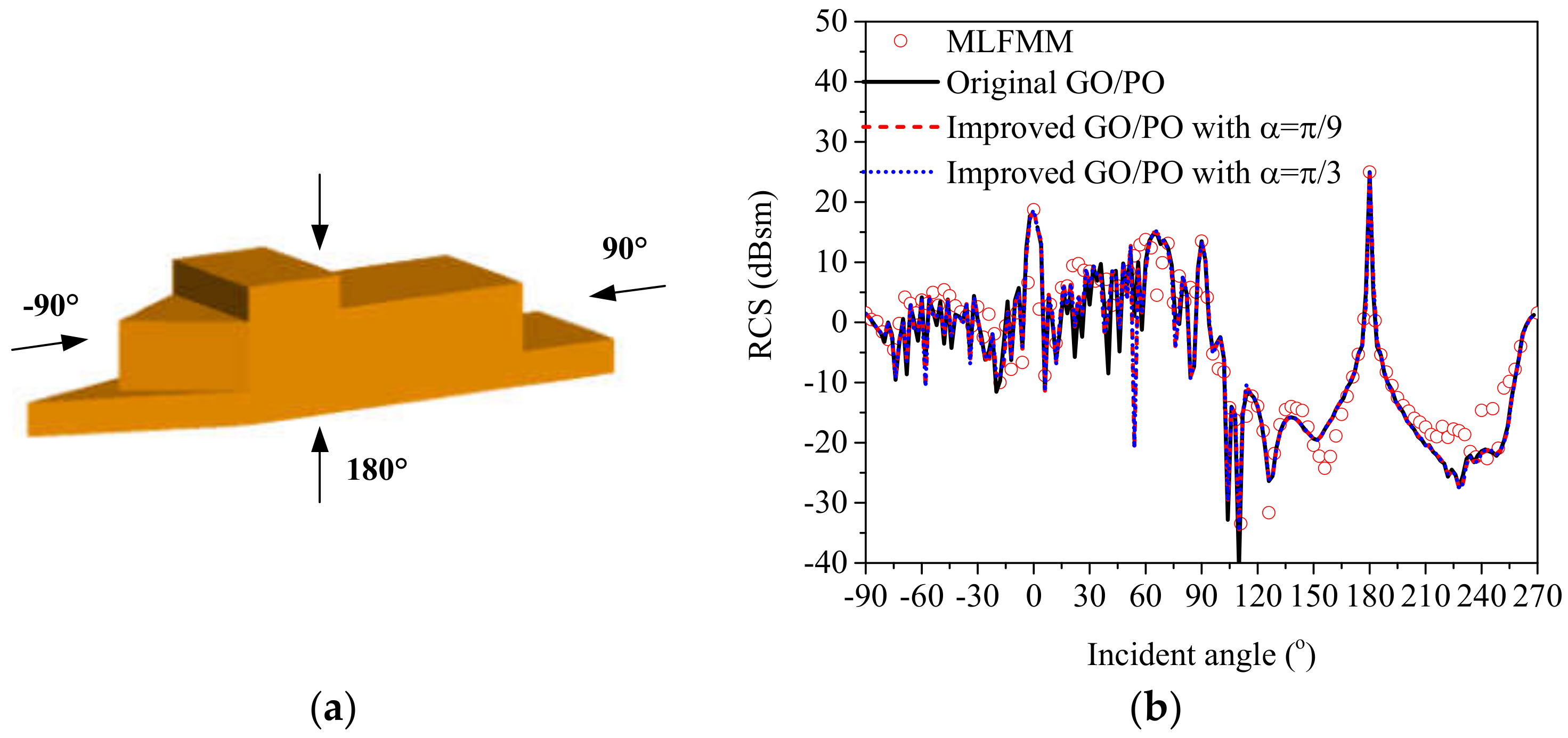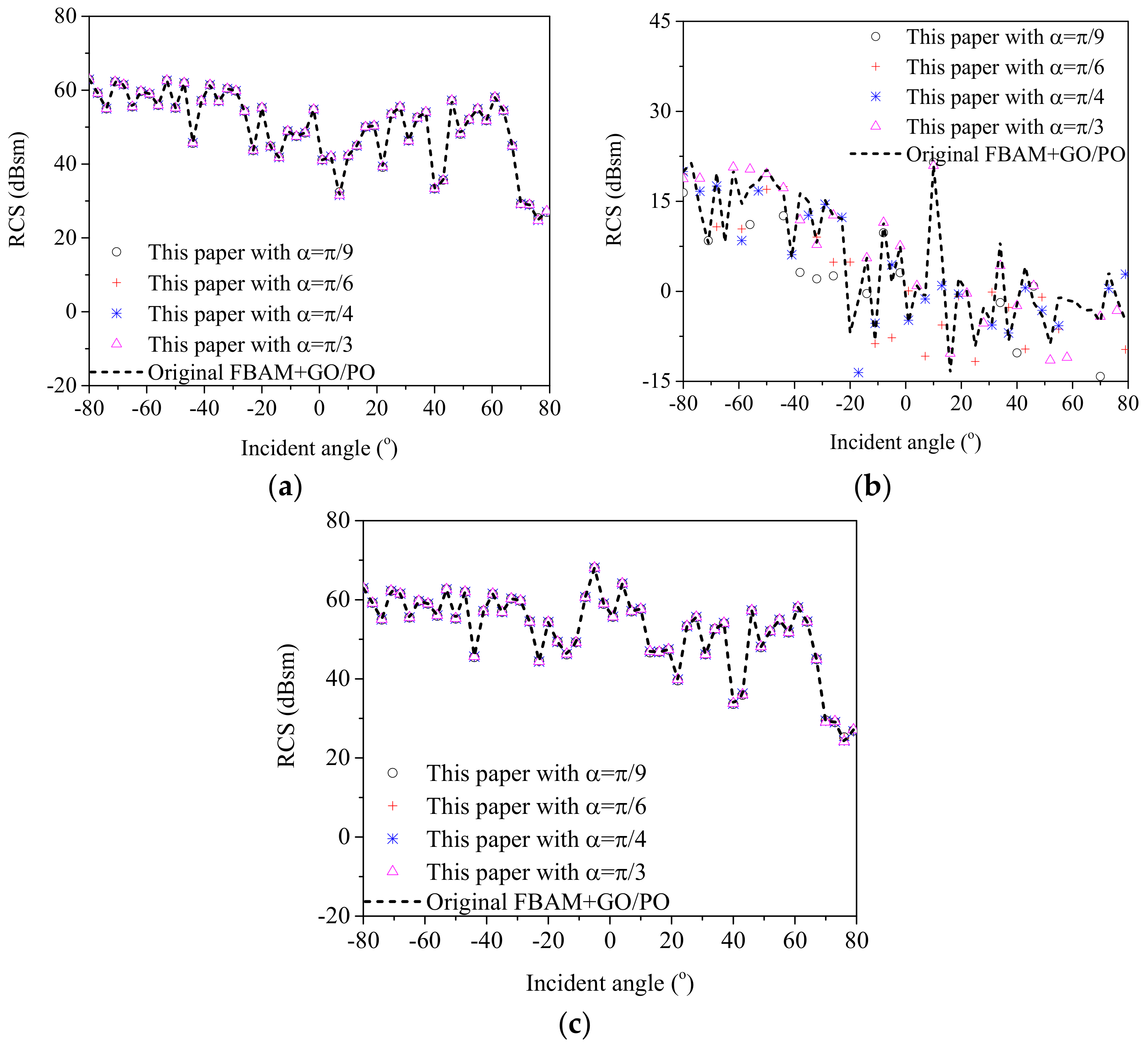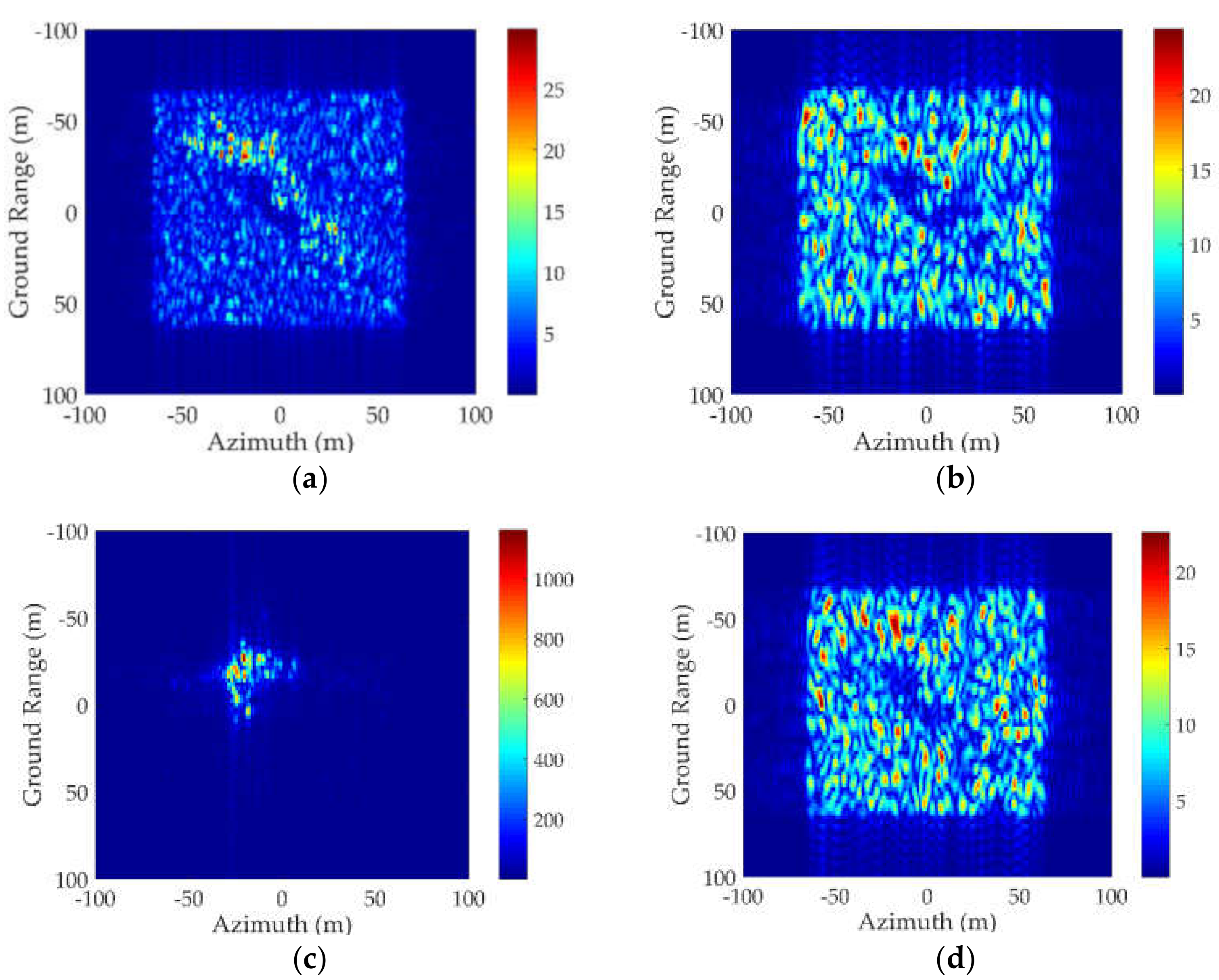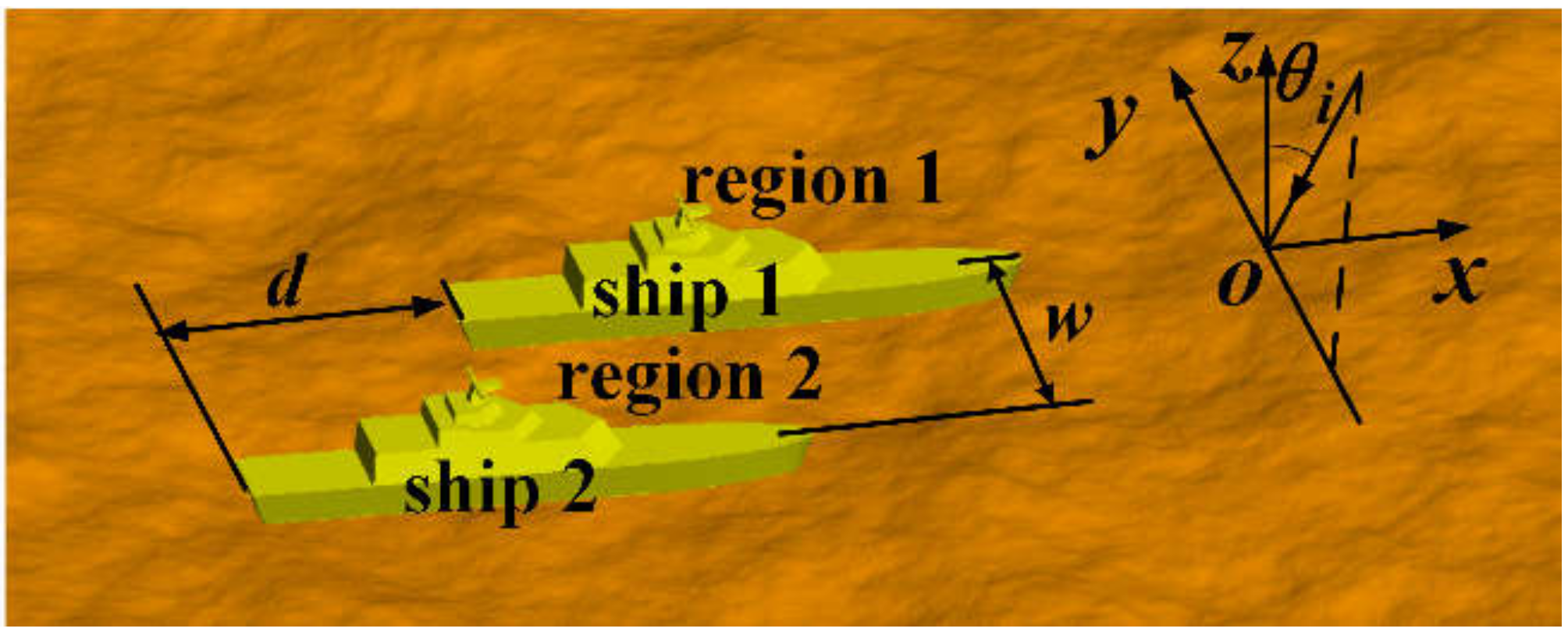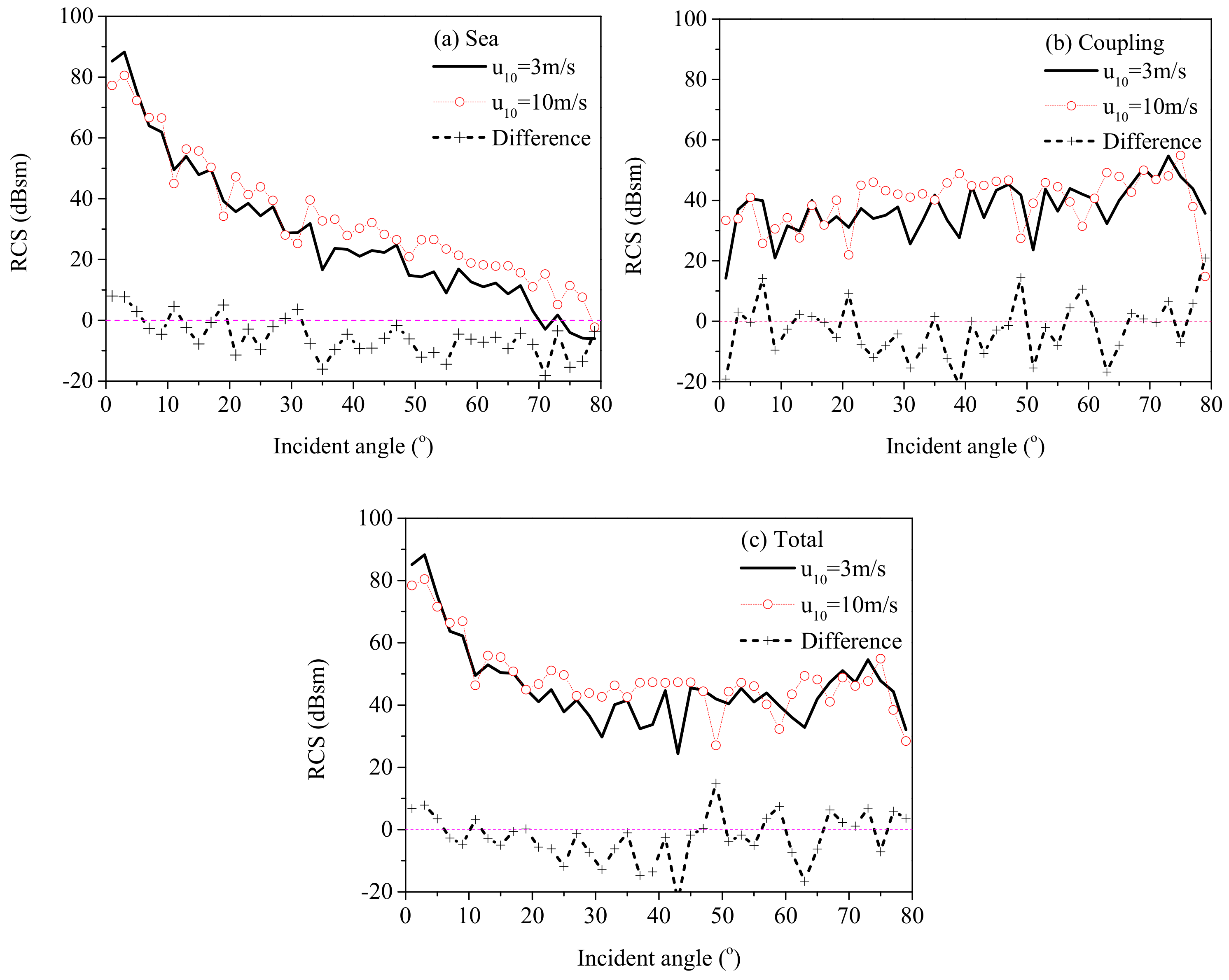1. Introduction
The study of microwave scattering from ship targets in a marine environment has been a challenge for a long time due to the complex structure of targets, the randomness of sea surfaces, and the interactions between them. In addition, the electrically large size of such a composite scene makes the scattering problem much more difficult. However, the related study is of great value in the field of target detection, target feature extraction, etc. Thus, this problem has been studied by many researchers and various of methods have been proposed to solve this problem despite its difficulty.
The existing methods can be roughly divided into three categories. The first include numerical methods such as the famous method of moments (MoM), the finite element method (FEM) [
1,
2], the finite-difference time-domain (FDTD) algorithm [
3], the time domain integral equation (TDIE), and other methods that have been developed based on them such as the forward-backward method (FBM) [
4], the multilevel fast multipole method (MLFMM) [
5,
6,
7], etc. The second category is the combination of numerical methods and high-frequency approximation methods. For this kind of method, the scattering field from rough surfaces and the targets are always calculated with high-frequency approximation methods and numerical methods, respectively. In [
8,
9], the combination of the Kirchhoff approximation method (KAM) and the MoM or MLFMM were used to analyze the scattering from a target over a rough surface. Compared with the pure numerical methods, they show a higher efficiency. Even so, the combination methods suffer from huge computational burden when solving the scattering from electrically large ships in a marine environment at higher microwave bands. The third kind include the pure high-frequency approximation methods such as the four-path model (FPM) [
10,
11], the iterative physical optics (IPO) method [
12], the ray-tracing based methods such as the shooting and bouncing ray (SBR) algorithm [
13], and the geometrical optics and physical optics (GO/PO) method [
14]. Among them, the GO/PO based methods are widely employed due to the lower memory costs, higher computation efficiency, intelligible mechanism, and reasonable results in practice. As for this kind of method, the total scattering field can be divided into three parts, namely, the direct scattering field from the sea surface, the direct scattering field from ship targets, and the coupling scattering field between them. The GO/PO method is used to predict the direct scattering field from the ship targets and the coupling scattering field. However, when calculating the higher-order scattering field from the ship targets and the coupling scattering field via the GO/PO method, the visibility judgement makes it inefficient if the size of the sea surface or the target is too large. Therefore, different methods are used to accelerate the GO/PO method such as the Kd-tree [
15] and the Open Graphics Library (OpenGL) technology [
16].
In this paper, another idea was proposed to accelerate the current GO/PO method by using the physical mechanism to reduce the invalid occlusion judgment between different patches, and this operation enhances the computational efficiency when dealing with the second-order scattering field from the ship target and the coupling scattering field between the ship target and the sea surface. Therefore, the proposed improved way was used to analyze the EM scattering from ship targets over a sea surface by combining with the fact-based asymptotic method (FBAM).
The rest of this paper is organized as follows. In
Section 2, the original /PO method is introduced briefly, then the improved idea is described in detail. In
Section 3, both the calculation accuracy and the efficiency of the improved method are compared with the original GO/PO method to show its good ability. Next, it is used to simulate synthetic aperture radar (SAR) images of a composite ship–ocean scene for detection purpose. In
Section 4, the proposed method is used to analyze the EM scattering characteristic of a marine environment with multiple ships. Finally, this work is concluded in
Section 5.
3. Validity and Application of the Improved Method
In this section, through different examples, the calculation accuracy of the improved GO/PO method for predicting the RCS from a pure target was proved first. Then, by combining with FBAM, the RCS results of composite ship–ocean scenes were calculated and compared with the original method to further prove the accuracy and efficiency of the proposed approach. Then, the proposed method was used to simulate the SAR images of a ship over a rough sea surface for the purpose of target detection.
- (1)
Example 1: A ship model
First, the radar cross section (RCS) of a simple ship model was calculated via the original GO/PO method, the improved GO/PO hybrid method, and the multi-level fast multipole method (MLFMM). The MLFMM is a fast algorithm based on the famous Method of Moments (MoM), which can reduce the storage requirements and low complexity of the matrix and vector multiplication effectively compared with MoM. As a low-frequency method, the good accuracy of MLFMM for solving electromagnetic scattering problems from objects has been proven in many studies [
5,
6,
7]. Therefore, the results calculated by the MLFMM were regarded as a comparison.
The geometric dimensioning of the simple ship model is shown in
Figure 3a, which was identical to that in
Figure 2a in [
19].
Figure 3b shows the monostatic VV-polarized RCS of the composite scene in the
plane at a frequency of 10 GHz, and the incident angle varied from
to
with an interval of
. The simulated results showed that the RCS results were largest near the normal incidence directions. The effectiveness of the improved GO/PO hybrid method was verified by good agreement with the MLFMM and the original GO/PO hybrid method. Moreover, the consumed time for calculating the RCS results with the MFLMM, the original GO/PO method, and the improved method are compared in
Table 1 to show the good efficiency of the proposed method.
- (2)
Example 2: A ship target on a rough sea surface
Figure 4 shows the geometry structure of a ship target on a sea surface, where the ship has a length of 120 m, a width of 20 m, and a height of 25 m. With the proposed method, the HH polarized backscattering RCS results corresponding to the scattering field from the ship, the coupling scattering field, and the total scattering field were calculated via the improved GO/PO method with different threshold angles. However, regarding electrically large objects (such as ships) at higher microwave bands, the MLFMM still suffers from a large computational burden. Therefore, for large ship targets, the good accuracy of proposed method can be proven only through a comparison with the original GO/PO method for large ships. The results were compared with those calculated by the original GO/PO method in
Figure 5. In the simulation, the incident frequency was 10 GHz, and the incident angle varied from −80° to 80°. The results of the comparison showed the good ability of the proposed method to evaluate the scattering characteristics from a composite ship–ocean scene.
Furthermore, the computation time for calculating the above results with different methods are also compared in
Table 2. It can be seen that the proposed way showed higher efficiency compared with the original GO/PO method. In addition, the calculation efficiency of the proposed method increases for a larger threshold value. However, if the threshold value is too large, the calculation accuracy decreases reversely. Therefore, an appropriate threshold value is necessary to balance the calculation accuracy and the calculation efficiency.
- (3)
Example 3: Another ship target on a rough sea surface
To show the good ability of the proposed method for analyzing the scattering from different shapes of targets, a composite ship–ocean scene with a different ship target is shown in
Figure 6. The geometrical dimension of the ship target is illustrated in
Figure 6a. With the proposed method, the HH polarized backscattering RCS results corresponding to the scattering field from the ship, the coupling scattering field, and the total scattering field were calculated via the improved GO/PO method with different threshold angles. The results were compared with those calculated by the original GO/PO method in
Figure 7. The simulation parameters were the same as those in
Figure 5. The comparison results showed that the proposed method performed well for the different ship targets.
- (4)
Application to SAR image simulation of a composite ship–ocean scene
Nowadays, with the development of SAR, it has been applied to the detection of ship targets in a marine environment. Therefore, based on the proposed scattering model, SAR images of a composite ship–ocean scene under different radar parameters and sea states were simulated and are shown in
Figure 8. The ship target is shown in
Figure 4a, and the size of the sea surface was 128 m × 128 m, and the wind speeds were 5m/s for
Figure 8a–c and 10 m/s for
Figure 8d. The angles between the ship bow-stern direction and the flight direction of the SAR platform were 45° for
Figure 8a,b,d and 90° for
Figure 8c. The resolution was 2 m × 2 m. The central frequency of the SAR was 5 GHz and the incident angle was 40°.
First, by comparing the SAR images with different polarization modes, it was seen that with a HH polarized radar, the ship target was much easier to detect by a SAR, the reason being that the radar echo from the sea surface is much weaker than that for a VV polarized radar. Second, if the radar flies parallel to the ship target, the corner structures of the ship usually lead to a strong intensity, which makes it much easier to be detected by SAR images. However, under such a condition, the shape of the ship target in SAR images cannot reflects the whole image of the ship, making it difficult to recognize ship targets. Finally, by comparing
Figure 8a,d, it can be seen that the wind speed has a great effect on SAR images because the echo from the sea surface is enhanced.
4. EM Scattering Characteristic of a Marine Scene with Multiple Ships
In this part, the improved method was used to analyze the EM scattering characteristics of a marine scene with multiple ships.
Figure 9 shows the composite ship–ocean scene. The two ships were the same as those in
Figure 4a. The center coordinates of ship 1 and ship 2 were (0, 0, 0) and (−d, w, 0), respectively.
First, the RCS results from a composite ship–ocean scene (
Figure 9 with
d = 25 m,
w = 30 m) was computed by the original method and the proposed method to show the good effectiveness of the proposed method for analyzing the scattering from multiple ships in a marine environment. Then, by comparing the three contributions to the total scattering field in
Figure 10, it was observed that the direct scattering field from the sea surface and the ships reached the maximum value for a perpendicular incident angle. Furthermore, it can be concluded that at small incident angles, the scattering from the sea surface was dominant due to the large region of the sea surface. At larger incident angles, the coupling scattering field may exceed the scattering field from the targets, so the coupling scattering field is obviously non-ignorable especially for large incident angles.
In addition, the coupling scattering field between the sea surface and the ships with different relative locations are compared in
Figure 11. Due to the randomness of the sea surface, the RCS results from the coupling scattering are were averaged over 10 composite scene samples with different sea surface elevations. By comparing the coupling scattering field between the two ships for different intervals along the
y-axis, one can see that there was no significant difference between the RCS results at small incident angles and very large incident angles. However, for intermediate incident angles, the coupling scattering field was larger for w = 150 m than that for w = 30 m. The reason is that when the incident wave illuminates the scene along the negative y-direction, the coupling scattering field contains two contributions: the coupling scattering field between ship 1 and the sea surface in region 1, and the coupling scattering field between ship 2 and the sea surface in region 2. If the distance between the two ships is large, the second contribution can be very large at intermediate incident angles. However, at small incident angles, it is weak because the reflected waves from the sea surface/ships illuminate the ships/sea surface only over a very small region. Furthermore, for large incident angles, the second contribution may vanish due to the shadowing effect.
Furthermore, the RCS from the sea surface, the coupling field, and the total field under wind speeds of 3 m/s and 10 m/s are compared in
Figure 12 to show the influence of the sea state. The difference
between the RCS results under different wind speeds is also shown in
Figure 12. In
Figure 12a, the RCS of the sea surfaces decreased for a higher wind speed in the specular directions, but increased at other incident angles, which is a logical phenomenon that in specular directions, the specular reflection dominates, thus the scattering field from a calm sea surface is stronger. However, for large incident angles, the diffuse scattering is the main mechanism. Therefore, the RCS increases with the wind speed. For the coupling scattering field, it was observed that the RCS from a rougher sea surface was higher than that of a calm sea surface at intermediate incident angles. Nevertheless, the difference was not obvious at small or large incident angles. Regarding the total scattering field in the
yoz plane,
Figure 12 shows that the scattering field from the sea surface and the coupling scattering field are the main contributions to the total scattering field at small and large incident angles, respectively. Thus, it has a similar trend with the scattering field from the sea surface at small incident angles, whereas it has the same trend with the coupling scattering field at intermediate and large incident angles.
